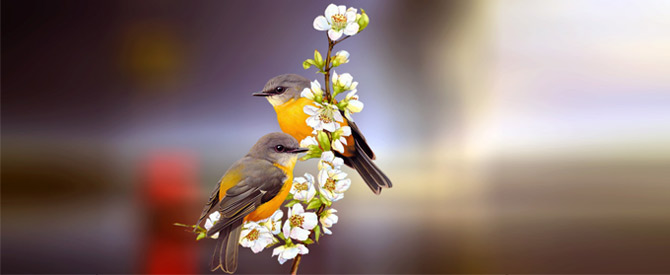A Timeless Tale of Two Birds

By: Manisha Melwani, Teacher, Writer and Speaker,
Author of “So You’re a Spiritual Being—Now What?”
In the ancient spiritual text called the Mundaka Upanishad of India, there is a well-known tale of two birds living in the same tree.
The simple story is an allegory for our spiritual journey, the goal and the challenges that we meet along the way.
Two birds, bound together in close friendship, live in a tree. One lives amongst the lower branches while the other, a dazzling golden bird, perches high up at the very top of the tree.
The lower bird keeps busy all day long, hopping from branch to branch, pecking and eating the fruits of the tree with relish. In trying to find the sweet fruits, it tastes many sour ones.
The higher bird has no interest in eating any of the fruits of the tree. It sits silently just watching the lower bird.
Once, the lower bird tastes a very bitter fruit. It shirks away and stops eating. It looks up and sees the peaceful and luminous higher bird. The lower bird is attracted by it and begins to hop up the branches.
Just then, it notices an especially nice-looking fruit and stops to peck at it. It finds it surprisingly sweet and tasty! “The higher bird can wait,” it thinks. So, it continues to hop from branch to branch, tasting the fruits of the tree.
Every now and then, put off by the taste of an unsavoury fruit, it stops and looks upwards at the higher bird, admiring its stillness and peace. It starts to hop up toward it only to be tempted by yet another luscious, sweet fruit.
One day, the lower bird eats a particularly tart fruit. Totally put off by the taste and tired of chasing after sweet fruits, it becomes determined to reach the higher bird.
It rises up the tree toward the higher bird, staying focussed and carefully avoiding the tempting sweet fruits along the way.
Soon, a surprising thing begins to happen—the lower bird begins to take on the qualities of the brilliant higher bird.
When it is very near the higher bird, it is irresistibly drawn to it. Finally, the lower bird merges to become the higher bird.
There it realises that it was never separate from the higher bird as there really was no lower bird. It was all an illusion, like a dream that fades away upon waking up.
The lower bird was essentially the radiant and serene higher bird all along.
The symbolic meaning of the story
The lower and higher birds: The lower and higher birds in this story represent the ego (the individual, you and I) and the Higher Self or the soul respectively.
As in the case of the two birds, the ego, the false “I” and the Self, the real “I” have an eternal friendship. They live together in the same body, no matter which body they take on. The tree represents the physical body.
The ego is in essence the peaceful higher Self. But it has forgotten its true nature and takes itself to be insecure and limited.
It seeks to regain its inherent fullness in the only way it knows—through the enjoyment of favourable things, people and situations in the outer world.
The fruits of the tree: The fruits of the tree represent the fruits of our karma—the results of our own good and bad past actions.
Our good past actions reap good karma and bring us happiness in the form of enjoyable experiences (the sweet fruits). Our not-so-good past actions reap bad karma which brings us suffering in life (the sour fruits).
Our present experiences are therefore based on our past actions. There is no escaping the Law of Karma and we always get what we deserve.
And so, despite the fact that we want only happiness, sorrow invariably intrudes on our lives.
The Self lives in the same body but it doesn’t enjoy or suffer because it has no interest in gaining any worldly joys. It is merely a witness, abiding in its full, peaceful nature.
The spiritual search begins
Every now and then when we experience some difficulties in life, we start to question our worldly pursuits and search for deeper happiness through spirituality.
But the lure of the world is very strong, and we stray from our spiritual path.
The Mundaka Upanishad tells us that the ego, sunk in ignorance of its own essential blissful nature, gets deluded and completely immerses itself into worldly preoccupations. Depending on the ever-changing and transient world for happiness, it is helplessly dragged into the cycle of joy and sorrow.
Finally, when we’ve had enough of the fruitless search for enduring happiness in the world, we turn inwards with determination and sincere interest. This is when we arrive at the threshold of spirituality.
The culmination of the search
When we pursue spirituality with genuine sincerity, our egocentric desires and personality start to crumble. We gain a greater inner poise and serenity as the beauty of the Self starts to shine through.
Finally, we rediscover our true spiritual nature and realise our oneness with it.
That’s when we come to know that the ego never really existed and the Self was always the only reality.
References
- The Tale of the Two Birds is found in the Mundaka Upanishad, 3.1.1–2.
Image of the two birds by kandhal keshvala from Pixabay
